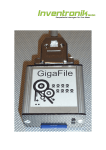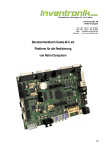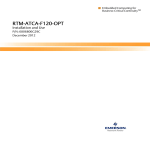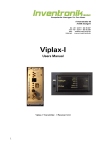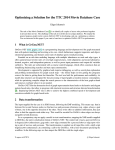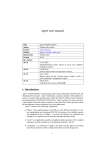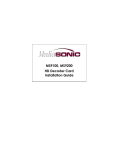Download Akai S950 User`s manual
Transcript
Suska GigaFile User's Manual Rev. 2.0 November 2012 Subject to change without notice. W. Förster Translation by John Kolak with support of Matthew Waller Contact Inventronik GmbH, Finkenstraße 48, 70199 Stuttgart. Internet: www.inventronik.de; www.experiments.de. Page 2 Email: [email protected] I want to thank all people contributing to this project. Have Fun. Wolfgang Förster Page 3 Table of Contents Introduction..........................................................................................................................................5 Description.......................................................................................................................................5 Compatibility Issues concerning SD Cards.....................................................................................6 One Word about the Transmission Data Rate..................................................................................6 Features............................................................................................................................................6 Operation of the GigaFile.....................................................................................................................7 LEDSignalling................................................................................................................................7 Inserting and Operation of SD Cards...............................................................................................7 Power Supply...................................................................................................................................8 Configuration of the ACSI/SCSI Identification Number.................................................................8 Bus Termination in the GigaFile's SCSI Mode................................................................................8 Tricks and Limits.............................................................................................................................8 Annex..................................................................................................................................................10 Pin Out of the 26 pos. ACSI/SCSI Connector...............................................................................10 Pin Out of a 19 position DSUB ACSI Connector.........................................................................11 Pin Out of a 25 position DSUB SCSI Connector.........................................................................12 Cable Assembly ACSIGigaFile....................................................................................................13 Cable Assembly SuskaIIICGigaFile..........................................................................................14 Cable Assembly SCSIGigaFile.....................................................................................................14 GigaFile connected to the internal Bus of STE and Stacy.............................................................15 GigaFile for use in the Akai S950 Sampler ...................................................................................16 Notes...................................................................................................................................................18 Index of Tables Table 1: Achievable Data Transfer Rates..............................................................................................6 Table 2: ID Configuration....................................................................................................................8 Table 3: Pin Out of the 26 pos. HDDSUB.......................................................................................10 Table 4: ACSI Pin Out of a 19 pos. DSUB........................................................................................11 Table 5: SCSI Pin Out of a 25 pos. DSUB........................................................................................12 Table 6: Cable Assembly GigaFileACSI Interface............................................................................13 Table 7: Cable Assembly GigaFileSCSI Interface.............................................................................14 Table 8: MegaSTE J402 (and Stacy, J11?) 30pos. Header to GigaFile HDDSub............................15 Index of Figures Figure 1: GigaFile PCB To View..........................................................................................................5 Figure 2: GigaFile PCB Bottom View..................................................................................................5 Figure 3: Layout of the 26 position HDDSUB.................................................................................10 Page 4 Introduction Description Suska GigaFile is a solid state disk, intended to work on Atari ACSI or SCSI interfaces. The physical memory SD cards are foreseen. In this way, the GigaFile is widely configurable using SDSC (cards with small capacity up to 2GiB), SDHC (cards with high capacity from 2GiB to 32 GiB) or SDXC (cards with capacities greater than or equal 32GiB). So this product should meet any individual requirements. The focus of development of the GigaFile was the compatibility to both bus protocols, the Atari Computer System Interface ACSI and the Small Computer System Interface SCSI. The Configuration of the desired bus protocol is done via the connecting cable or adapter. The electronic circuitry is placed on a double sided mounted printed circuit board which has an area of 50x40mm². The boxed GigaFile measures 60x55x30mm³. Therefore it has a volume which is a factor of 80 times smaller in comparison to Atari's 20MiB hard disk drive SH205! Beside the 26 position HD DSUB connector and the connector for the SD card, the GigaFile is equipped with two LEDs indicating the operation status. The development of the GigaFile went hand in hand using the current version of the HDDRIVER hard disk driver from Uwe Seimet. Optimizations for this driver are implemented in the digital logic, so it is recommended to use a recent version of HDDRIVER (8.45+) with the GigaFile. The functionality and the technical data described in this manual refer to the GigaFile Slim R02. This version number is indicated while booting with HDDRIVER. SJ1 SJ2 SJ3 PAR_EN TDR Figure 1: GigaFile PCB To View Figure 2: GigaFile PCB Bottom View Page 5 Compatibility Issues concerning SD Cards All SDSC, SDHC, SDXC cards, which can handle blocks of 512 Byte size, are suited for the operation in the GigaFile. Some SDSC cards with a capacity of more than 1GiB may not work properly. This behaviour is described in detail in the section Tricks and Limits. To verify if a card is suitable or not, it can for example be inserted into a card reader connected to a Windows PC. Open the formatting dialogue. There is a setting, 'Cluster Size'. In conjunction with the FAT file system, you should see cluster sizes of 8192 Bytes or less. In this case the SD card is usable in the GigaFile. One Word about the Transmission Data Rate With the new configware R02 an optimized management of the data transfer rate is introduced. A measurement as in the configware R01 is now obsolete. The GigaFile adjusts automatically to a maximum value. In the table below the data transfer rates which can be expected are listed. Atari ST read Atari ST write 1200kByte/s 1000kByte/s SuskaIIIC read SuskaIIIC write TT read TT write 1800kByte/s 1200kByte/s 1800kByte/s 1200kByte/s Table 1: Achievable Data Transfer Rates If there are nevertheless problems which assumably are caused by a too high data transfer rate, there is the configuration bridge TDR (see 2). If TDR is closed the GigaFile runs with reduced data transfer rate. Due to these optimizations, the GigaFile R02 is compatible to more hardware and robust against critical data bus timings. Features The operation of the GigaFile in principle is possible at any SCSI or ACSI bus with any hard disk driver. The ACSI bus has limitations concerning the maximum size of the inserted SD cards; the maximum usable size is limited to 1GiB when SDSC, SDHC or SDXC cards are used in conjunction with any hard disk drivers. To remove this limitation, the GigaFile can operate in conjunction with modern hard disk driver (HDDRIVER) SCSIII compatible commands. Thus it is possible to use SD cards with higher capacities than 1GiB at full capacity. There are also limitations of the maximum size of a partition and the maximum number of partitions of the operating systems used (TOS, MINT etc.). Again, the detailed information in this documentation is based on the use of a current version of the hard disk driver HDDRIVER from Uwe Seimet (version 8.45 or above). The reason for this choice is on the one hand, the fact that HDDRIVER is the only one which has been in active development for many years (from 1989 to the present), and on the other hand the development of the GigaFile has taken place by intensive use and testing with HDDRIVER. The GigaFile detects the type of the inserted SD card automatically. In principle it is possible to remove the SD card during the operation at the ACSI port (for example to exchange data with a notebook) and reinsert it for further use without a restart of the Atari computer. GigaFile can operate all types of SD cards. There are no limitations during the operation if HDDRIVER is used. SDSC cards are configured during the start up sequence of the GigaFile to handle blocks of 512 bytes. SDHC and SDXC cards also work with a block size of 512 bytes. It may Page 6 occur that some SD cards do not work properly. Reasons, therefore, may be incompatible supply voltage ranges or cards with block sizes different from 512 bytes. The supply voltage is 5V and is connected beside the ACSI and SCSI bus signals to the 26 position HDDSub header. To connect the GigaFile to the Atari ST or to any SCSI interfaces, use the respective cable adapters or one of the PCB adapters which are separately available at Inventronik GmbH. To connect the GigaFile to the SuskaIIIC board, use a 1:1 wired 26 pos. HDDSub cable (male female) or connect it directly, that is without cable, to the ACSI header of the SuskaIIIC. The GigaFile is inactive if there is no SD card inserted. As in the SCSIII specification parity check is enabled by default. If the GigaFile is operated on a hardware which does not support the parity bit, this option is disabled, if the configuration bridge PAR_EN (siehe 2) is closed. Operation of the GigaFile LEDSignalling Once connected to the host computer and an SD card is inserted, the GigaFile is ready for preparation or use without any further action required. Both LEDs (green and red) will indicate information about the operating condition. Each of the two LEDs indicate two operating conditions as follows: The green LED starts flashing for about 5s after a system start or after the SD card was removed and is inserted again. The flash frequency depends on the type of the inserted SD card. If an SDSC card is detected which relies on the SD card specification 1.x, the frequency is about 1Hz. 2 Hz results from SDSC cards relying on the SD card specification 2.x. SDHC and SDXC cards cause a frequency of about 4Hz. After five seconds the LED is switched on permanently, but with reduced intensity, indicating correct operating condition of the GigaFile. The red LED is switched on with reduced intensity after a system start up and if the SD card is inserted. The same condition occurs if the SD card is removed and inserted again. This condition means that the Card is operating with a reduced transmission data rate, which is important for the TOS boot option and also to operate the GigaFile correctly on systems with slow direct memory access (DMA) channels. Access to the SD card is indicated with light pulses of full intensity. Once HDDRIVER become active, the transmission data rate to or from the GigaFile is switched to a high value after the first INQUIRY command is executed and if TDR is not closed (see above). With this trick booting from TOS operating systems in a reduced speed mode is possible. Inserting and Operation of SD Cards SD cards in standard form factor are inserted upside down (contacts on top) into the GigaFile SD card slot. Removing and inserting works with a pushpull mechanism. As soon as an SD card is removed and another one is inserted, it will be initialized immediately and the card parameters are switched transparently to the hard disk driver. The GigaFile reads the Write Protection Sliders of SD cards, so the respective warnings will be shown if there is an attempt to write to a protected card. Attention! If the cards are removed during read or write access, a complete data loss cannot be ruled out. If cards are set up with HDDRIVER and the option, TOS/WIN compatible partitions, it is possible to exchange data from the GigaFile to any personal computer without restarting the host of the GigaFile. Do not remove cards and insert different cards. In this way there is also the possibility Page 7 of a complete data loss on the inserted card. If the user is not completely aware of the behaviour of the operating system in connection with the hard disk driver, it is strongly recommended to change the cards after the host has been shut down. Power Supply There are several possibilities to power the GigaFile. This mainly depends on the system to which it is connected. In principle there are the following three options: 1. Connected SuskaIIIC 2. Connected to a 19 pos. ACSI port. 3. As SCSI device, for example, in conjunction with a 25 pos. DSUB adapter. Configuration of the ACSI/SCSI Identification Number On the top of the printed circuit board of the GigaFile there are three configuration bridges (solder types, see 1). The respective ID number is selected, shortening these bridges partially or entirely. The following table lists all possible ID numbers and the respective settings of the bridges. The default factory setting of the GigaFile is ID 0. SJ1 SJ2 SJ3 ID SJ1 SJ2 SJ3 ID Open Open Open 0 Closed Open Open 4 Open Open Closed 1 Closed Open Closed 5 Open Closed Open 2 Closed Closed Open 6 Open Closed Closed 3 Closed Closed Closed 7 Table 2: ID Configuration Bus Termination in the GigaFile's SCSI Mode A correct bus termination is a prerequisite for a stable and accurate operation. The GigaFile is not equipped with an internal bus termination circuitry, so there is a need for an external termination. This is possible with a single ended termination, for example, from the host's side. This is possible when the cable is short. Another way is to use external bus terminators. Please be aware that there may be only two terminators located on each end of the SCSI bus, even if more than two devices are connected. Deselect all internal bus terminations which are not required to meet this arrangement. Tricks and Limits This chapter describes some known issues concerning the operation of the GigaFile in conjunction with the connected hardware and the hard disk driver used. The contexts are often not trivial and Page 8 sometimes it seems that the SD cards or the GigaFile won't work correctly. The following things were found during intensive testing. 1. SDSC cards with block sizes greater 512Byte: Some SD cards seem not to handle blocks of 512 bytes. This does not conform to the SD card specification. Among these are, for example, 2GB SDSC cards. The SDSC specification reserves 12 Bit addresses and a maximum multiplication factor of 512. So there are a maximum of 2¹² * 512 = 2.097.152 blocks. To create 2GB cards, the blocks size is not 512MB but 1024 MB. Those cards are not possible to operate in the GigaFile. Use SDHC cards instead. 2. During the boot process from the GigaFile, the transmission data rate of the connected computer will be measured as described above. This is to allow the TOS operating system to boot from the card correctly. The reason for this feature is a race condition in TOS. Booting from hard drives is not possible if the data is read too slow or too fast. Although the GigaFile is developed carefully and with intensive testing to meet this requirement, there is no guarantee that all the different hardware will boot from SD card in every case. A workaround is to use HDDRIVER booted from a floppy disk drive or from another hard disk connected to the IDE port, which can be found in STEs, Stacys or STBooks. 3. The GigaFile supports the HDDRIVER option, Fast ACSI. If HDDRIVER is used with this setting, the read and write transmission data rate is about 15% higher. 4. If big SD cards are connected and partitioned with HDDRIVER, there is a need for the option, ICD compatibility. Otherwise partitions which are located beyond the 1GB limit are not detected and there is no way to access them. In this case HDDIVER gives a warning during the boot process, “Error while reading the partition data“. 5. Even if more than one partition is installed with TOS/Win compatibility during partitioning with HDDRIVER, the Windows operating system detects only the first one. This is not an error, but more a poor feature of Windows. 6. During Partitioning or Formatting the SD cards, there are unwanted warnings or errors: in this case have a look on the write protection slider of the inserted SD card. Perhaps it is (by accident) switched to write protection. Page 9 Annex Pin Out of the 26 pos. ACSI/SCSI Connector Pin No. Function 1 Data Bus Bit D7 2 GND 3 Data Bus Bit D6 4 SCSI_ATNn 5 Data Bus Bit D5 6 GND 7 Data Bus Bit D4 8 GND 9 Data Bus Bit D3 10 SCSI_DPn 11 Data Bus Bit D2 12 GND 13 Data Bus Bit D1 14 GND 15 Data Bus Bit D0 16 GND 17 ACSI_SCSIn 18 SCSI_IOn 19 VCC 20 ACKn 21 REQn 22 CSn_DCn 23 RSTn 24 CA1_MSGn 25 INTn_BUSYn 26 CRWn_SELn Figure 3: Layout of the 26 position HDDSUB Table 3: Pin Out of the 26 pos. HDDSUB Remark: The pin numbers are normally marked on the DSUB connectors. If not, take care of the fact that the numbering is ascending in comparison to other headers, and not alternating, but row wise. Page 10 Pin Out of a 19 position DSUB ACSI Connector Pin Nr. Function 1 DB0 2 DB1 3 DB2 4 DB3 5 DB4 6 DB5 7 DB6 8 DB7 9 /CS 10 /INT 11 GND 12 /RESET 13 GND 14 /ACK 15 GND 16 A1 17 GND 18 R/W 19 /DRQ Table 4: ACSI Pin Out of a 19 pos. DSUB Page 11 Pin Out of a 25 position DSUB SCSI Connector Pin No. Function 1 /REQ 2 /MSG 3 I/O 4 /RST 5 /ACK 6 BSY 7 GND 8 DB0 9 GND 10 DB3 11 DB5 12 DB6 13 DB7 14 GND 15 C/D 16 GND 17 /ATN 18 GND 19 /SEL 20 PARITY 21 DB1 22 DB2 23 DB4 24 GND 25 TMPWR Table 5: SCSI Pin Out of a 25 pos. DSUB Page 12 Cable Assembly ACSIGigaFile GigaFile 26 pos. Cable Colour ACSI 19 pos. Power Supply LIYCY 21 1 white 8 2 black 11 3 brown 7 4 (n.c.) 5 green 6 6 greenbrown 13 7 yellow 5 8 bluewhite 15 9 grey 4 10 (n.c.) 11 pink 3 12 greywhite 17 13 blue 2 14 pinkbrown 15 red 1 16 (n.c.) 17 (n.c.) 18 (n.c.) 19 pinkwhite 20 whiteyellow 14 21 browngrey 19 22 whitegreen 9 23 violet 12 24 yellowbrown 16 25 redblue 10 26 pinkgrey 18 0V VCC (+5V) Table 6: Cable Assembly GigaFileACSI Interface Page 13 Cable Assembly SuskaIIICGigaFile The GigaFile is best fitted to SuskaIIIC. It is pluggable directly to the SuskaIIIC ACSI connector without the use of a cable. If a cable should be used, it is a 1:1 wired 26 pos. HDDSUB cable assembly with one end having a female connector, and the other end male. Cable Assembly SCSIGigaFile GigaFile 26 pos. Cable Colour SCSI 25 pos. LIYCY 25 1 whiteyellow 13 2 pink 9 3 whitered 12 4 bluebrown 17 5 grey 11 6 bluewhite 16 7 yellow 23 8 (n.c.) 9 green 10 10 red 20 11 black 22 12 pinkgrey 14 13 purple 21 14 yellowbrown 18 15 redbrown 8 16 blackwhite 24 17 pinkwhite 7 18 pinkbrown 3 19 blue 25 20 greywhite 5 21 bluered 1 22 greenwhite 15 23 greenbrown 4 24 browngrey 2 25 white 6 26 brown 19 Table 7: Cable Assembly GigaFileSCSI Interface Page 14 GigaFile connected to the internal Bus of STE and Stacy VCC +5V 26pol.HD-Sub-D Pin 19 VCC +5V VCC +5V frei 26pol.HD-Sub-D Pin 21 REQn 26pol.HD-Sub-D Pin 24 CA1_MSGn 26pol.HD-Sub-D Pin 20 ACKn Data Bus Bit D7 > Data Bus Bit D6 > Data Bus Bit D5 > Datenbus-Signale von (MegaSTE U403 (74LS245)) kommend Data Bus Bit D4 > Data Bus Bit D3 > Data Bus Bit D2 > Data Bus Bit D1 > Data Bus Bit D0 > 30 28 26 24 22 20 18 16 14 12 10 8 6 4 2 29 27 25 23 21 19 17 15 13 11 9 7 5 3 1 GND GND GND 26pol.HD-Sub-D Pins 2, 4, 6, 8, 12, 14, 16 INTn_BUSYn 26pol.HD-Sub-D Pin 25 CRWn_Seln 26pol.HD-Sub-D Pin 26 CSn_DCn 26pol.HD-Sub-D Pin 22 RSTn 26pol.HD-Sub-D Pin 23 Data Bus Bit D7 > Data Bus Bit D6 > Data Bus Bit D5 > Data Bus Bit D4 > Data Bus Bit D3 > Data Bus Bit D2 > Data Bus Bit D1 > Signalweiterleitung zur externen 19.pol ACSI-Buchse. Bei Fehlen des internen Host-Adapters Pins entsprechend brücken, damit ext.ACSI funktioniert! (2-1, 4-3, 6-5, 8-7, 10-9, 12-11, 14-13, 16-15) Data Bus Bit D0 > Mit freundlicher Unterstützung von U. Stapelkamp. Table 8: MegaSTE J402 (and Stacy, J11?) 30pos. Header to GigaFile HDDSub Page 15 GigaFile for use in the Akai S950 Sampler This tutorial is written by Jamel Naitizgui in April 2013. The GigaFile is compatible with the Akai S950 (IB105 Hard Disk Board installed). How to get the GigaFile working with the Akai S950 Sampler: Important: only 2GB and 4GB SD cards are compatible. This is not a drawback because the S950 has a memory standard of 750kB which is expandable up to 2.25MB. Be aware, that 2GB cards may fail to work with the GigaFile. For more information refer to paragraph Compatibility Issues concerning SD Cards. Steps do get the things running : 1. Format the SD card in your computer using FAT or EXFAT file system. 2. Connect the GigaFile to the S950 and insert the SD card. 3. Press the "DISK" button then go to option *09 *FORMAT FLOPPY _ *FORMAT SH204/5 _ *WIPE HARD DISK _ TOTAL FREE 0% 4. Move cursor pointer to: *FORMAT SH204/205 and press the enter button. The S950 takes 2 seconds to format the SD card. Now the total free disk space is: 9413% with 750kB standard memory and respective lower values if the standard memory is increased from 750kB. This means in detail, that you can save exactly the same amount of memory on a SD card, no matter if you use a 2GB card or a 4GB card. Regarding the inexpensive price of a SD card, this will save money compared to floppy disks. 5. How to make the S950 recognize the GigaFile: • Press "DISK" and then option *01 VOLUME SLCT , CREATE FLOPPY S900 *HD CONT 1 *HDRIVE 1 *RENAME FLOPPY UNFM% • Move cursor pointer to "SLCT" • 5C. Turn the JOG control and press ENTER button. Now you can read the following on the screen: • *01 VOLUME SLCT , CREATE V1 • *HD CONT 1 *HDRIVE 1 *RENAME 1 UNFM% • At this point, volumes must be created to store data. 6. How to create volumes on the SD card to store data: • Press "DISK" then option *01 VOLUME SLCT , CREATE V1 *HD CONT 1 *HDRIVE 1 *RENAME 1 UNFM% • Move cursor pointer to "CREATE" • Press the "+" button and then press the "ENTER" button Page 16 Now two volumes are created on the SD card. Verify this with the "SLCT" option and proceed with step 5. On this screen you have now the choice between V1 and V2: *01 VOLUME SLCT , CREATE V1 (turn JOG control to select V2 ). *HD CONT 1 *HDRIVE 1 *RENAME 1 UNFM% Repeat step 6 every time you need to create volumes. A maximum of 128 volumes can be created on a SD card but around 70MB can be stored on a 2GB or 4GB SD card. This is a little bit more than the 64MB which can be stored on a 100MB ZIP disk with the optional IB109 SCSI board installed. The GigaFile is perfectly working with the optional IB105 ACSI board installed and did not freeze or crash up to now. Page 17 Notes Page 18


















